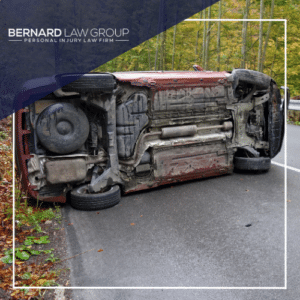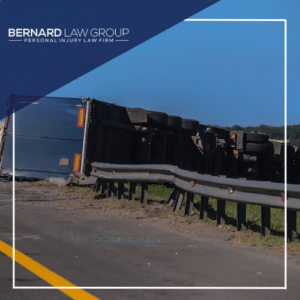Rollover crashes are rare compared to other car accidents. They only account for 3% of all serious accidents. Even though they are rare, they are most likely to cause a fatality.

The issue was not with the vehicle body but the tires. The issue was first recognized in the late 1980s; however, the “problem” vehicles were still released for sale to the public, leading to numerous lawsuits.
While automakers today address this issue regularly, vehicles are not immune to rolling over in an accident. Because of this, it is important to learn more about these accidents and your rights if you are injured or someone you love is killed in one.
At Bernard Law Group, we understand the impact a rollover accident can have, and our Seattle car accident lawyers can help you understand your rights and take steps to ensure they are protected.
Understanding Rollover Accidents
A rollover accident means the vehicle has rotated 90 degrees (or more) on its longitudinal axis and ends up sitting on its roof or side, sometimes returning to an upright position on all four wheels.
When this accident occurs, it is either tripped or un-tripped.
Tripped Rollover Accidents
A tripped rollover happens when a vehicle’s tires dig into soft soil or strike a guardrail, curb, or something else. When this happens, the impact results in the vehicle leaving the road and sliding sideways. Tripping accidents can be caused by:
- Uneven pavement surface
- Soft shoulders or soil
- Curbs
- Guardrails
- Snow banks
Other objects can also cause this. The force of the vehicle’s tires tripping causes it to roll over.
Un-Tripped Rollover Accidents
As the name implies, un-tripped rollover accidents occur when a vehicle rolls over because of a driving maneuver. No object or road condition causes the “tripping.”
This type of rollover accident is extremely rare and accounts for less than five percent of incidents. Usually, this occurs in top-heavy vehicles (like SUVs) when they speed and make sudden maneuvers to avoid a collision.



You Were Hurt. We Can Help.
Over $500 Million recovered for our past clients. Let us help YOU! Call 24/7 for your FREE injury consultation.
Why Are Rollover Accidents So Dangerous?
It is not uncommon to hear news of deadly accidents on the roads in and around Seattle. For example, on I-5 near Arlington, a rollover accident led to the death of one at the beginning of April 2024.
Other incidents include semi-trucks rolling over and cargo being spread over multiple lanes of traffic. These accidents are not only serious, but they lead to significant backups and delays.
While numerous factors can cause a rollover accident, these tend to be the most likely to cause fatalities. One reason for this is that those inside the affected vehicle did not have a seatbelt in most incidents. This often leads to them being ejected from the vehicle as it rolls.
Common Causes of Seattle Rollover Accidents
Rollover accidents may not be common, but when they occur, there is a high possibility of serious injuries and fatalities for those involved. Some of the most common causes of these accidents include:
Urban Challenges and Pedestrian Encounters
In Seattle, rollover accidents often occur because drivers must execute sudden maneuvers to avoid unexpected obstacles, such as pedestrians or cyclists. This is particularly common in the densely populated areas of the city where people are constantly coming and going.
Additionally, Seattle’s well-known rainy weather adds another layer of danger, creating slippery road conditions that can make it difficult for drivers to maintain control, particularly if they’re traveling too fast for the conditions.
Road Design and Maintenance Issues
Seattle is known for its beautiful, hilly landscape and winding roads; however, this requires drivers to pay close attention and exercise significant control over their vehicles. Road maintenance issues, including potholes and poorly marked construction zones, can catch drivers off guard, possibly leading to sharp turns that increase the risk of a vehicle rolling over.
Highways and Speed-Related Factors
The combination of high speeds and sudden lane changes on Seattle’s highways can significantly increase the likelihood of rollover accidents. The differential in speed between heavy trucks and passenger vehicles can force drivers into making quick, destabilizing maneuvers.
Aggressive driving behaviors such as speeding and tailgating only heighten the risk, leaving less room for error and reaction.
The Role of Vehicle Type
The prevalence of SUVs and pickup trucks in Seattle, known for their higher centers of gravity, contributes to the city’s rate of rollover incidents. These vehicles are more susceptible to rolling over in sharp turns or collisions than lower-profile vehicles.
Impairment and Late-Night Driving
Alcohol or drug impairment continues to be a leading cause of rollover accidents in Seattle. Impaired judgment and reduced reaction times significantly affect a driver’s ability to safely maneuver through the city’s varied driving environments, with late-night hours seeing a spike in such incidents due to decreased visibility and increased likelihood of driver impairment.
What Vehicles Are Most Likely to Be Involved in a Rollover Accident

SUVs and Pickup Trucks
SUVs and pickup trucks are among the vehicles most susceptible to rollover accidents, primarily due to their higher centers of gravity. This design characteristic makes them more likely to tip and roll during sharp turns or collisions.
Compared to lower-profile vehicles, their taller stature increases the risk of rollovers, particularly in situations requiring sudden directional changes.
Commercial Vehicles and Large Trucks
Commercial vehicles and large trucks also fall into the high-risk category for rollovers. The heavy loads they carry can shift unexpectedly during transit, potentially destabilizing the vehicle during maneuvers or when making sharp turns.
Additionally, the size and height of these vehicles contribute to a higher center of gravity, amplifying the risk of tipping over under certain conditions.
Vans
Vans, especially those configured for passenger transport or cargo, have a higher likelihood of rollover accidents. Like SUVs and trucks, vans often have a higher center of gravity, especially when fully loaded. This factor, combined with their boxy shape, can increase wind sensitivity, challenging the driver’s ability to maintain control.
Older Model Cars
Older model cars, lacking modern safety features and stability control technologies, are more likely to be involved in rollover accidents. These vehicles may not be equipped with advanced systems designed to help prevent loss of control or minimize the risk during sharp turns and emergency maneuvers.
Vehicles with Poor Maintenance
Vehicles not properly maintained, regardless of type, are more prone to experiencing a rollover. Issues such as worn-out tires, faulty brakes, or damaged suspension systems directly affect the vehicle’s stability and handling capabilities. Poor maintenance can exacerbate the risk of rollovers, especially under adverse driving conditions or when unexpected situations arise on the road.
Your Rights After a Seattle Rollover Accident
Our Seattle rollover accident attorneys are here to help if you are involved in a rollover accident. At Bernard Law Group, we offer free initial consultations to discuss your needs and claims.
Contact our office to speak to our team. We can help you recover the compensation you deserve after any accident and injury.


